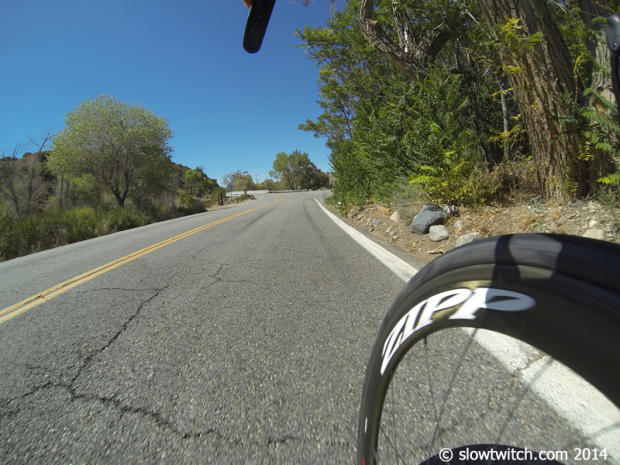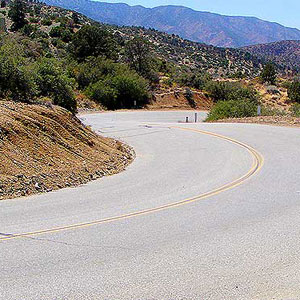The Big Loop – Angeles Crest Century
[Dan wrote this article a long time ago, and it's hidden away on the "old" site. It was actually as a result of doing this ride for the very first time back in 2005 that I met Dan for the very first time in person. I've made a bunch of trips around this loop since then, really returning to it as a way to gauge and build my fitness after my bike wreck in 2010. Since then, whenever I feel like I need to sort myself out, I head up here and do this ride. This past Sunday, with Dan as SAG, I did it again and captured a bunch of photos. The reason for the change in perspective on some is that part of my GoPro mount failed about halfway through and I had to remount the camera in a different location. I left all the GoPro photos "as is" – meaning uncropped – since I think it gives a nice perspective on how you see this route, even though it deprives you of some of the spectacular vistas you see to the left/right. Next time… Dan original text below remains unchanged. – Jordan]
This ride features the Angeles Crest Highway, one of the great mountain roads anywhere. But there’s more to this loop than the Angeles Crest, and this century—almost all of which takes place within the Angeles National Forest—includes roads you should know but almost certainly don’t.
A good part of this loop looks out over the L.A. Basin, but none of it takes place in L.A. proper. In fact, we’ll pay you a buck if you ever see a traffic light during this entire ride. Like any loop, this ride can be started at any point around it. I started it in Valyermo, at 3600’ of elevation overlooking the 2600’ high desert that is called Antelope Valley (find Hwy 138 on the map and everything north of that is Antelope Valley, leading all the way to Death Valley). I started here because it can get steamy down at 3000’—the low elevation of this ride—and I thought it better to tackle this 15-mile segment in the morning rather than during the heat of the afternoon and at the end of a boatload of climbing.
Descending gently a mile or two from Valyermo on Big Pines Highway you’ll come to Pallet Creek Road, and you’ll turn left and then make a quick right on Fort Tejon Road.
(NOTE: For those who want to make a true century out of this ride, stay on Pallet Creek Road. It’ll dead end into Longview road after a hop and a skip, and Longview (turn left) will ascend to its terminus at Juniper Hills Rd. The only way you can go is right, and this will take you back down to Fort Tejon Rd. further along the way. This extra loop is quite scenic and will get you much of the way toward 100 miles.)
Whichever way you choose, stay on gently undulating and rural Fort Tejon Rd. for several miles until you come to a left-hand turn called Mt. Emma Rd. Shortly after that turn Fort Tejon Rd. dead-ends into Pearblossom Hwy (#138), so if you find yourself there you’ve just passed Mt. Emma Rd.
For the next half-dozen or so miles Mt. Emma doesn’t turn much at all, and it’s my least favorite part of the ride. I don’t like any road that’s straight. The road isn’t flat, mind you, it’s just that it’s straight. In fact, the undulations are deceiving, and as will be described later these early miles are hillier than you notice. Thankfully this road gets twisty as it starts to climb in earnest and the desert scrub turns gives way to pinon pines and larger junipers. At the summit I met two riders coming in the other direction, and we shared a few words. They were surprised to see me because they never (they said) saw riders out here, which was a mystery to them as this is such prime riding territory.
I descended the other side of Mt. Emma Rd., and this would be the first of many, many summits reached on this ride—a lot more than I reckoned on.
Mt. Emma Rd. dead-ends into Angeles Forest Hwy (N3), not to be confused with Angeles Crest Hwy (#2). N3 would be considered an alpine road anywhere else, except compared to the Angeles Crest it’s just a cub scout. Stilll it’s another nice stiff climb, and at its summit, several miles up the road, there’s a ranger station with a spigot and I recommend refilling your water bottles, as there is no other place to refill for a good while. This summit is also the first of many times this ride will cross the Pacific Crest Trail.
The Angeles Forest Hwy is then descended westbound, toward L.A., and after a healthy loss of altitude the rider will want to pay close attention to a left-hand turn called Upper Big Tugunga Canyon Rd. There is no sign here saying that this road leads to Angeles Crest Hwy but it does, and this very pretty undulating road is what you want to take. (You can miss this "short cut" intentionally if you want and add 15 or 20 miles to the ride, since N3 will eventually dead-end into #2, at a spot 1500' lower in altitude).
You’ll spend, I don’t know, maybe 9 miles in Upper Big Tujunga Canyon. The final couple of miles ascend out of it, and about a quarter of a mile from its intersection with the Angeles Crest Hwy the knowing eye will spy a very healthy 25-foot tall Giant Sequoia on the other side of the road (it looks like a Cedar but it isn't). Who planted it there, and why they (rightly) thought it would prosper is anyone’s guess (in the wild Sequoias neither grow this low in elevation—4500'—nor this far south). This road dead-ends into the Angeles Crest Highway, and until you make your left turn onto Big Pines Highway and descend to your car you won’t have to worry about any more roads to look for.
Heck, you’re 45-miles into this ride, exactly halfway, and it just doesn’t seem like it’s that hard of a ride. What you don’t realize is that you already have a good three thousand feet of vertical in your legs, although you haven’t climbed anything monumental.
At this intersection you’re 4700’ above sea level. Over to the right you'll notice Mt. Wilson, atop which sits an observatory and about a hundred antennas. All L.A. radio stations beam down from Mt. Wilson. Somehow those radio waves are able to cut through the smog and find their way to your car.
At this point you're already a good distance up toward the road’s high spot of 7900’. Climbing 3200’ on a road that isn’t throwing that much of a pitch at you. Certainly this road isn’t steep doesn’t sound all that hard. But it’s a royal pain in the arse as those who’ve ascended it will tell you. The reason is, you’ll spend more than 30 miles on this road, and it doesn’t just climb up to the summit and descend over that distance. It climbs to a bit over 5000’ and then descends, and then it climbs up to 6000’ and descends, and then after you’ve just about had enough climbing you pop out at the top and a sign that herald's "Cloudburst Summit . 7008'."
You figure, "That’s got to be it." Nope, not even close. You descend a good deal from here, to be sure, and after this free-fall of several miles you start up again and not for just a little bit. You don’t stop climbing until you’re at Dawson Saddle, 7901'.
Again you descend, this time an even longer downhill than any of the others. But you're not done. Prepare to climb again, this time another thousand or so feet to Lightning Ridge, which sits at 7400’.
Now the descent is for real, and shortly you reach Big Pines Hwy on the left. If you were to miss this road you'd only have to go two or three miles to attain Wrightwood, a charming mountain village that would not be a bad place as a staging area for this ride, especially for those coming from San Diego or Riverside.
The descent on Big Pines Hwy will take you from 6600' to about 3600' and includes some A+ hairpins and S-turns for the downhillo-philes among you. In the 15 miles between here and Valyermo you'll add 20 degrees F at least, and while down here I was hot in a short-sleeved jersey, above 7000' I was wearing a vest and a head warmer during the "heat of the day," even on the uphills.
The Angeles Crest Hwy clearly isn't designed to get you from A to B. It's reason for existence is to allow Angelenos to see their forest, and to gaze down on their city from high up. Very high up.
The route. With elevation map. It's not actually a century – only 93 miles (149km) – but with over 10,000ft (3,000m) of climbing, it makes up for it.
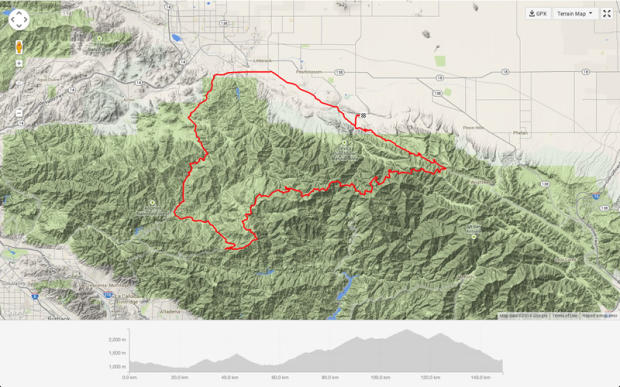
The loop technical starts at the right hand turn up ahead, turning off of Bob's Gap Rd. (Dan's street) onto Valyermo Rd.

The early part of the ride is hot, rolling through the desert of Antelope Valley. You'll see a lot of Joshua Trees. And sand. And there is no shade. High here in the summer is well over 100F.
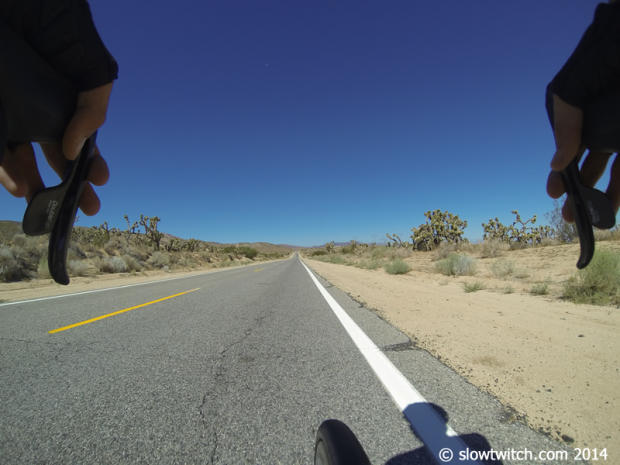
The "DIP" sign on Mt. Emma Rd. is your sign that the serious climbing is about to start. You will encounter many "it MUST end just around this bend moments after this." Note: it does NOT end just around this bend… This is the steepest climb of the day, and it comes early.
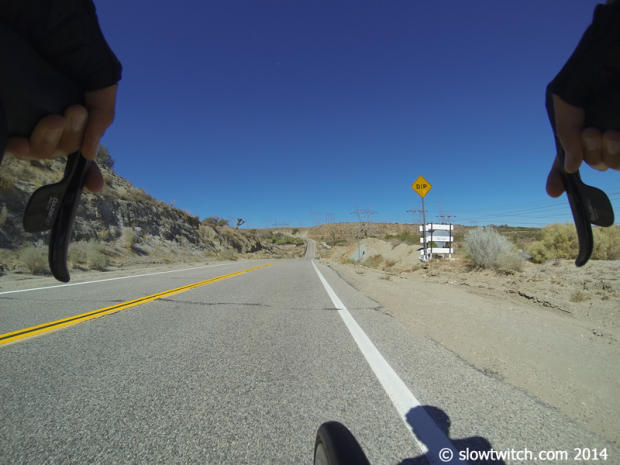
Once onto the Angeles Forest Highway, you'll start seeing the pine trees that dominate this ride. There are many, many different kinds. You need a book – and a lot of time – to learn them all. You will also note that the road continues to go up.
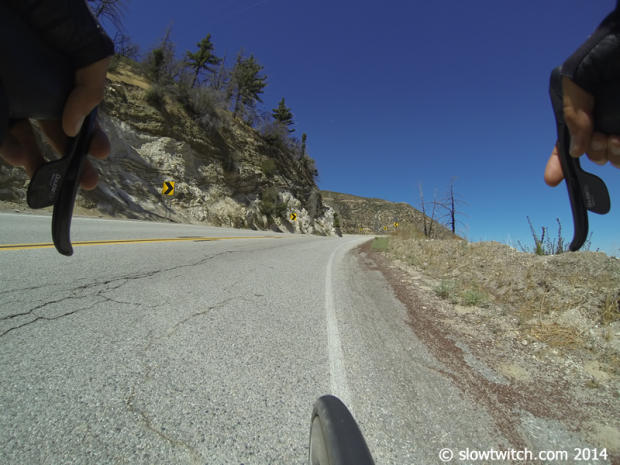
Upper Big Tujunga Canyon Rd has the best pavement on the route. It's also a bit of a shortcut between Angeles Forest Hwy and Angeles Crest Hwy and is immensely popular with motorcyclists because it's quiet (no cops) and the pavement is good. It's a rolling road, but it finishes with a good solid climb that's steep but not too long. That takes you up onto the crest.
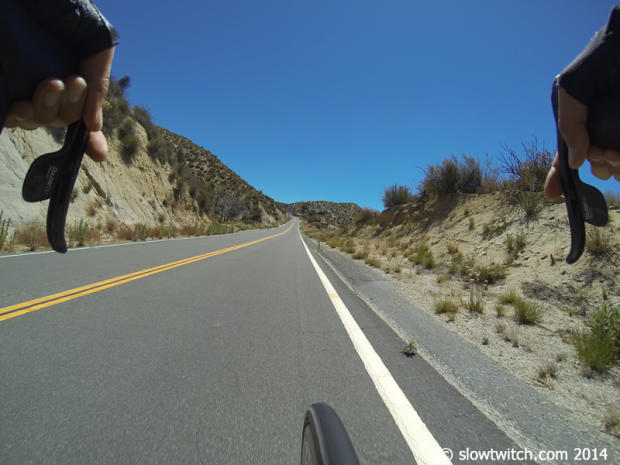
There are very, very few water stops on this route. Probably too few to do it in the summer without SAG. Never has Dan's truck been such a welcome sight. This is right before we hit the really hit peaks.
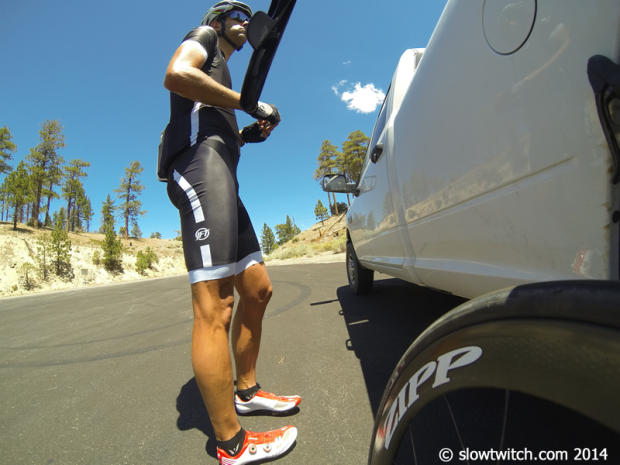
Now we're starting to get into the high country. This is up over 6,500ft on the way to the first high summit, close by the two ski areas (before climate change anyway…): Mt. Waterman & Snowcrest. Mt. Waterman offers scenic chair lift rides in the summer. Typically, it's much cooler up here, though today, the heat never really broke.
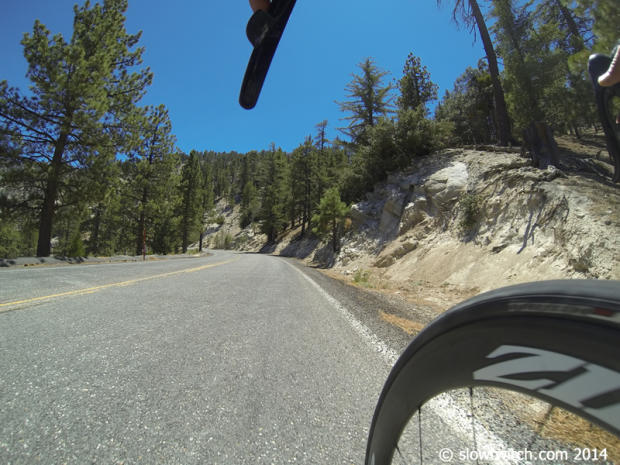
Cloudburst Summit – 7,018ft. The air up here is perfect. Hard to imagine we're so close to one of the largest cities in the world.
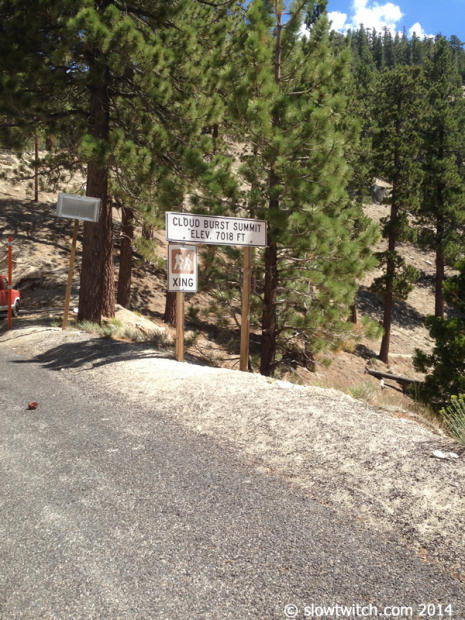
The white rocks along this route seem to come out of nowhere. The road carves through them at times, but mostly it follows the flow of the mountains.
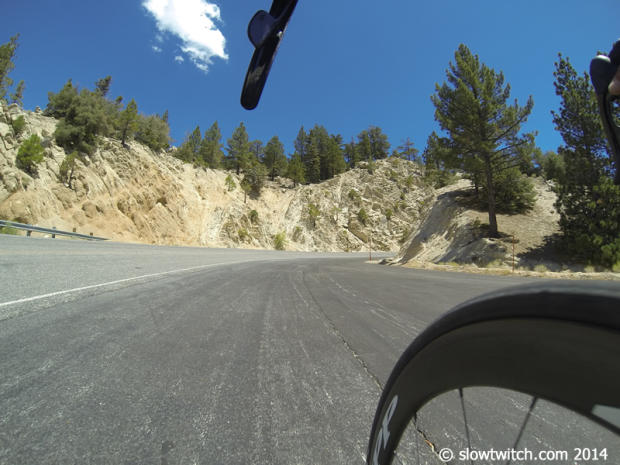
There are a lot of these yellow signs advertising hard U-turns. This one is on the way up. But there are plenty more on the way down. That's what makes this a road bike ride. Doing this on aerobars is not fun (I've done it).
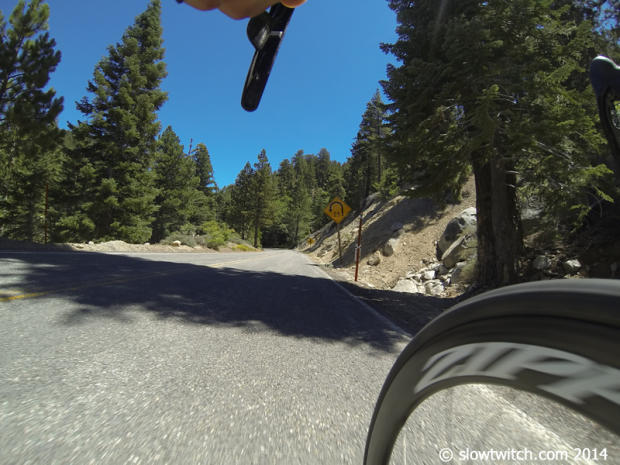
The road continues to climb seemingly endlessly. But it's truly spectacular, with either the Antelope Valley off your left to the North or the bulk of the Angeles National Forest (with LA just beyond it) off to your right to the South.
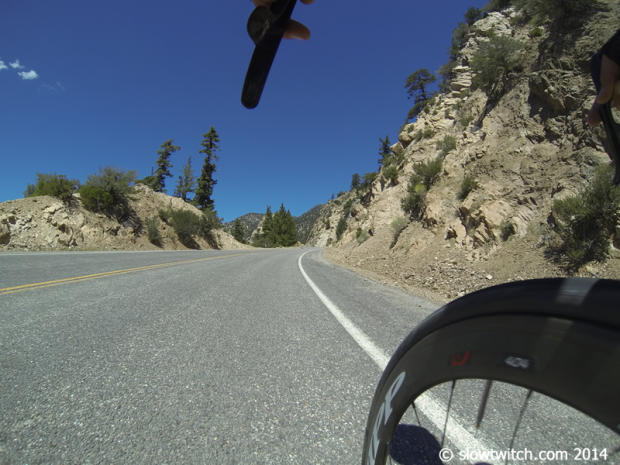
There are two tunnels on the route (in immediate succession). The first is actually quite long and make sure you take your glasses off going on. I also use my light (which I have as a safety flasher for most of the ride) in here because it's pretty black. It's also about the only shade you'll get on the whole ride.

On the way up to the highest point of the ride, you don't quite cross tree line, but you'll notice the trees are getting much smaller and shorter. The lack of snowfall has also hurt them. The fire risk is unspeakably high in the forest right now.
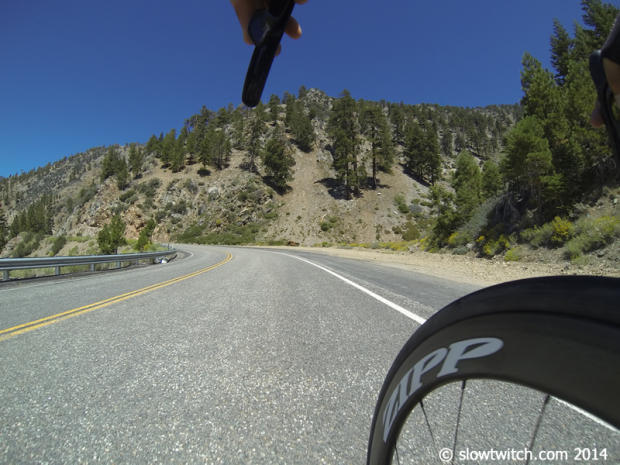
Dawson Saddle: 7,901ft. The high point of the ride. You can run from here on trails up to 9,300ft. Most people don't realize there is such high altitude so close to the Pacific ocean. Some years, this can be snowed in hard. But not in a while. Still, the air up here is the coolest and clearest it is on the whole ride. Like LA must have been everywhere before all us millions showed up…
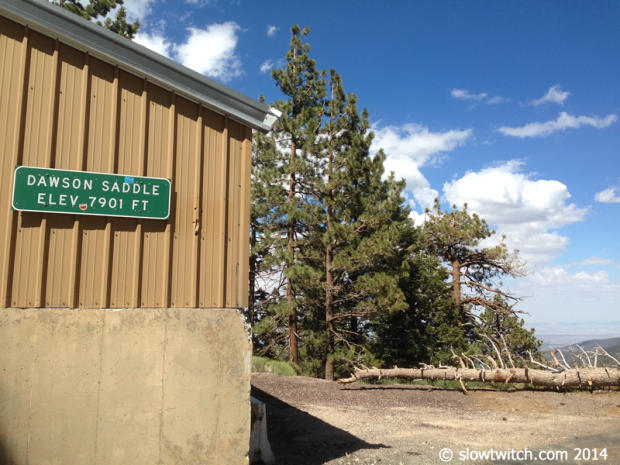
The last real climb of the day. It's not that steep. Or that long. But by this point, you're plenty tired.
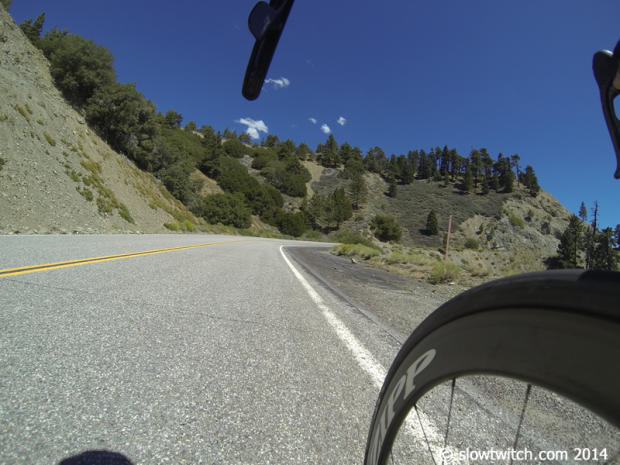
Blue Ridge Summit: 7,381. I think this is the most scenic of all the summits, which clear lines of sight in all directions. There's a great scenic overlook that takes in almost the whole of the Angeles Forest. A most welcome sight because it's all downhill from here.
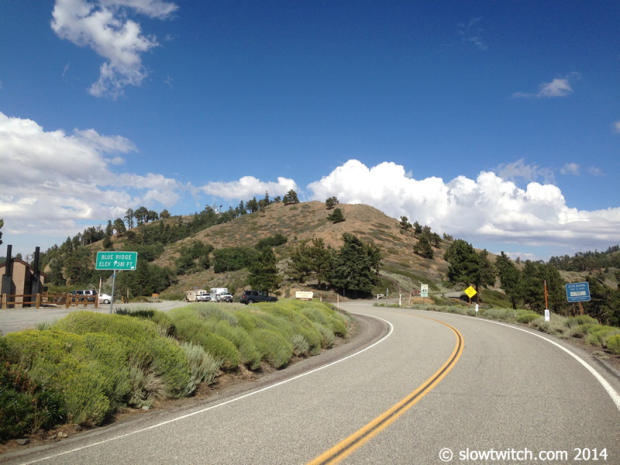
The descent from Big Pines is some of the most fun you can have on two wheels. Make sure your brakes work though.
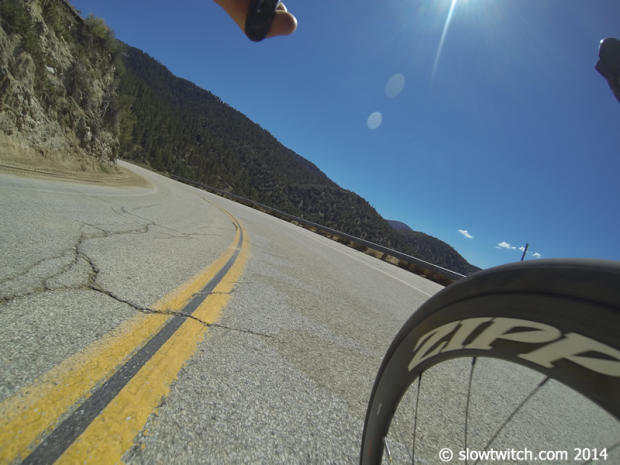
See those mountains? That's where we just were. Way up there…
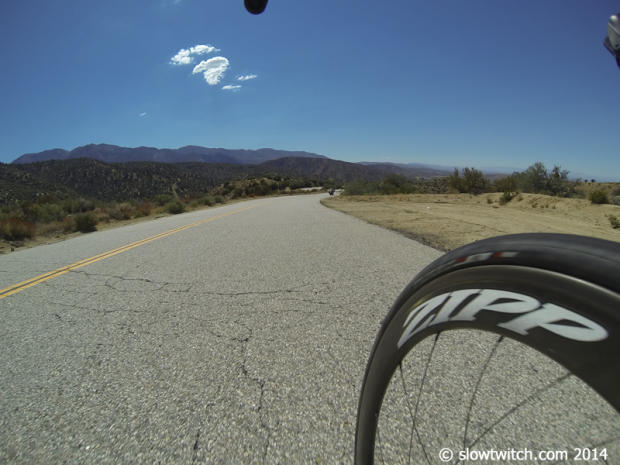
And here we are, right back at the start, just at that little bridge over the creek.
